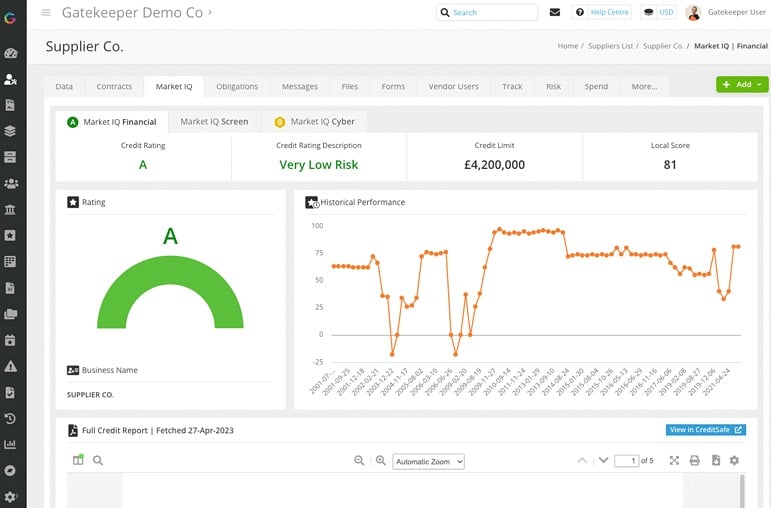The Five Pillars of an Effective Supplier Management Program
13:52
Supplier Management, Suppler Management Software, Control
Shannon SmithMay 2, 2025 9:30:00 AM
Across industries like financial services, life sciences and manufacturing, the challenges regarding supplier management are intensifying.
According to the 2025 BDO Life Sciences CFO Outlook Survey, for example, life sciences CFOs are contending with supply chain and manufacturing challenges, including the looming threat of tariffs and the Biosecure Act, which could disrupt the sourcing of materials for drug development.
Other challenges include:
A robust supplier management program is essential for addressing these challenges and driving financial performance.
By implementing a structured, proactive approach to managing supplier relationships, your organisation can gain control over costs, ensure compliance, maximise supplier value, and build resilience into its supply chain.
A supplier management program is a formalised, structured approach to managing relationships with suppliers across the full lifecycle from onboarding to offboarding.
It provides a framework for:
These outcomes are essential for protecting the bottom line, particularly for organisations in regulated industries.
They can be difficult to achieve, then maintain, using traditional manual or spreadsheet-based methods. If your business is still using manual methods to support its supplier management program, it raises the possibility of:
A supplier management program is crucial because supplier issues can directly impact the bottom line, especially when the number of suppliers is growing fast.
To maximise financial return and minimise risk, a supplier management program must be built on five core pillars. Each pillar addresses a critical component of effective oversight and is significantly enhanced by modern supplier management software like Gatekeeper.

Inefficient and ineffective supplier onboarding processes drain resources and delay time-to-value. Manual tasks are time-consuming, error-prone and inconsistent, and hinder scalability as supplier numbers grow.
Automating supplier onboarding and lifecycle processes is crucial for achieving cost efficiency, accuracy and auditability.
By streamlining these processes, organisations can:
Supplier management software enables your organisation to streamline and automate supplier processes, dramatically reducing onboarding times and improving data accuracy.
With Gatekeeper you can:
This not only accelerates onboarding but also ensures that supplier data is accurate and up-to-date, providing a reliable foundation for future management activities and financial reporting.

Not all suppliers contribute equally to an organisation's strategic objectives, or pose the same level of risk. Treating all suppliers the same leads to inefficient resource allocation and missed opportunities to maximise ROI from key relationships.
Supplier segmentation is essential for prioritising oversight based on factors such as criticality to the organisation, spend level and risk profile. By prioritising segmentation as part of your supplier management program, your organisation can:
Segmentation ensures that the right suppliers receive the right level of attention, enhancing their performance, mitigating risk, and maximising value for the organisation.
Without clearly defined KPIs to set expectations, and a robust system for tracking achievement against targets, supplier performance can deteriorate over time.
This can lead to missed service level agreements (SLAs), decreased service quality, and reactive firefighting, all of which negatively impact costs and profitability. Gatekeeper's robust performance management capabilities provide the transparency and accountability needed to drive continuous improvement in supplier performance and ensure cost control. For example, Gatekeeper allows you to:
Reporting and collaboration ensure that supplier relationships are data-driven, transparent, and aligned with commercial outcomes, ultimately contributing to improved cost control and value assurance.
Today's supplier risks are increasingly complex and variable, encompassing cybersecurity threats, ESG concerns, financial instability and geopolitical volatility.
Failure to proactively identify and mitigate these risks can expose your organisation to significant financial losses, non-compliance penalties and reputational damage.
A mature supplier management program embeds continuous proactive risk identification and mitigation into every stage of the supplier lifecycle, safeguarding your organisation's long-term operational capability and financial interests. It allows you to:

When supplier spend data is fragmented across procurement, finance, and contract teams, the lack of overall visibility creates blind spots, duplication, and uncontrolled costs, hindering efforts to optimise financial outflow and maximise ROI.
Gatekeeper provides comprehensive spend management capabilities that enable organisations to gain visibility into their supplier spending, control costs, and optimise their procurement strategies.
With Gatekeeper, finance and procurement teams can work collaboratively to optimise supplier value, reduce costs, and drive strategic sourcing decisions that improve the organisation's financial performance.
.jpg?width=1113&height=927&name=GK_Spend_Module_Dashboard_Zoom-3%20(1).jpg)
.png?width=720&height=300&name=Copy%20of%20The%20ongoing%20benefits%20will%20be%20significant.%20Gatekeeper%20will%20help%20with%20version%20control%20over%20template%20documents%2c%20streamline%20processes%2c%20meaningful%20reporting%2c%20assist%20the%20legal%20team%20with%20prioriti%20(1).png)
Before Gatekeeper, Redwood Logistics managed suppliers and contracts manually, with each department operating in silos. This fragmented approach meant critical supplier information, such as spend data and contract terms, was often inaccessible, creating inefficiencies and missed opportunities for negotiation.
Gatekeeper’s Impact:
“The ROI is the visibility of the contracts and the actual spending… we can do a better job negotiating those ahead [of renewals] or going to market and finding better deals.” - Gubio Henrique, Senior Vice President of Sourcing and Purchasing
Gatekeeper enabled Redwood Logistics to transition from reactive oversight to a proactive, strategic supplier management approach. Through real-time data, process automation, and tight NetSuite integration, they turned supplier management into a value driver - not a bottleneck.
A robust supplier management program is an essential capability for achieving financial stability, managing costs effectively, ensuring compliance, mitigating risks, and building a resilient supply ecosystem.
By focusing on the five pillars - automation, segmentation, performance, risk, and spend - your organisation can develop a supplier management strategy that delivers immediate financial impact and long-term value.
Supplier management software is the key enabler for establishing these pillars. Request a demo today to see how Gatekeeper can transform your process and drive significant improvements in efficiency, cost savings and risk mitigation.

Shannon Smith bridges the gap between expert knowledge and practical VCLM application. Through her extensive writing, and years within the industry, she has become a trusted resource for Procurement and Legal professionals seeking to navigate the ever-changing landscape of vendor management, contract management and third-party risk management.
Sign up today to receive the latest GateKeeper content in your inbox.
.png)
.png)
.png)
-4.png)
Before Gatekeeper, our contracts
Anastasiia Sergeeva, Legal Operations Manager, BlaBlaCar
were everywhere and nowhere.
Gatekeeper is that friendly tap on the shoulder,
Donna Roccoforte, Paralegal, Hakkasan Group
to remind me what needs our attention.
Great System. Vetted over 25 other systems
Randall S. Wood, Associate Corporate Counsel, Cricut
and Gatekeeper rose to the top.
Thank you for requesting your demo.
Next Step - Book a Call
Please book a convenient time for a quick call to discuss your requirements.